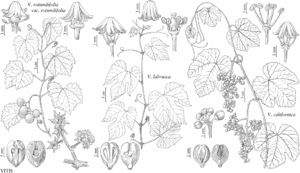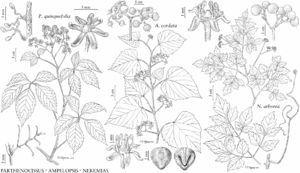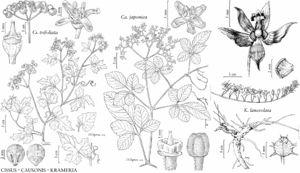Vines or lianas, occasionally shrubby [trees], synoecious, dioecious, or polygamomonoecious; commonly with multicellular, stalked, caducous, spheric structures (pearl glands); tendrils usually present, rarely absent. Leaves alternate, simple or palmately or pinnately compound; stipules present; petiole present; blade often palmately lobed, margins dentate, serrate, or crenate; venation palmate or pinnate. Inflorescences bisexual or functionally unisexual, axillary or terminal and appearing leaf-opposed, cymes or thryses [spikes]. Flowers bisexual or unisexual; perianth and androecium hypogynous; hypanthium absent; sepals 4–5(–9), connate most or all of length; petals (3–)4–5(–9), distinct (connate distally, forming calyptra, in Vitis) [connate basally], valvate, free; nectary intrastaminal; stamens (3–)4–5(–9), opposite petals, distinct; anthers dehiscing by longitudinal slits; staminodes present in functionally pistillate flowers; pistil 1, 2[–3]-carpellate, ovary superior, 2[–3]-locular, placentation axile, sometimes appearing parietal; ovules 2 per locule, apotropous or anatropous; style 1; stigma 1 [4]. Fruits berries. Seeds 1–4 per fruit.
Distribution
North America, Mexico, West Indies, Central America, South America, Eurasia, Africa, Indian Ocean Islands, Pacific Islands, Australia, primarily tropical and subtropical with a few genera in warm temperate to temperate regions.
Discussion
Genera 15, species ca. 900 (6 genera, 30 species in the flora).
In the past decade, considerable effort has been made to reconstruct the phylogeny of Vitaceae (M. Rossetto et al. 2001, 2002; M. J. Ingrouille et al. 2002; A. Soejima and Wen J. 2006; Wen et al. 2007; Ren H. et al. 2011; A. Trias-Blasi et al. 2012; Lu L. M. et al. 2013; Wen et al. 2013b; Zhang N. et al. 2015). These analyses have generally supported five major clades within Vitaceae: the Ampelopsis clade, the Ampelocissus-Vitis clade, the Parthenocissus-Yua clade, the core Cissus clade, and the Cayratia-Cyphostemma-Tetrastigma clade.
Placentation type and ovary locule number in Vitaceae have been interpreted in different ways. Most authors state that the gynoecium is bilocular and the placentation type is axile (for example, J. E. Planchon 1887; P. K. Endress 2010), but others report the gynoecium as unilocular and refer to the placentation type as parietal (V. Puri 1952; N. C. Nair and K. V. Mani 1960). Recent anatomical studies confirm that the ovary in Vitaceae is usually bilocular [occasionally trilocular in Cayratia, or unilocular in some species of Cyphostemma (Planchon) Alston, such as Cyphostemma sandersonii (Harvey) Descoings], and that the placentation is axile, although it may sometimes appear parietal (S. M. Ickert-Bond et al. 2014).
Selected References
Lower Taxa
Illustrations
Key
| 1 | Leaves 2–3-pinnately compound. | Nekemias |
| 1 | Leaves simple or palmately compound. | > 2 |
| 2 | Pith brown; petals connate distally, forming calyptra; bark exfoliating (adherent in Vitis rotundifolia). | Vitis |
| 2 | Pith white; petals distinct; bark adherent. | > 3 |
| 3 | Petals 4; stamens 4. | > 4 |
| 4 | Inflorescences leaf-opposed; seeds 1(–4) per fruit. | Cissus |
| 4 | Inflorescences axillary; seeds 2–4 per fruit. | Causonis |
| 3 | Petals 5; stamens 5. | > 5 |
| 5 | Tendrils 2-branched; nectaries cup-shaped, adnate proximally to base of ovary, free distally; styles elongate, cylindric. | Ampelopsis |
| 5 | Tendrils 3–12-branched; nectaries annular, adnate to base of ovary, or absent; styles short, conic. | Parthenocissus |


